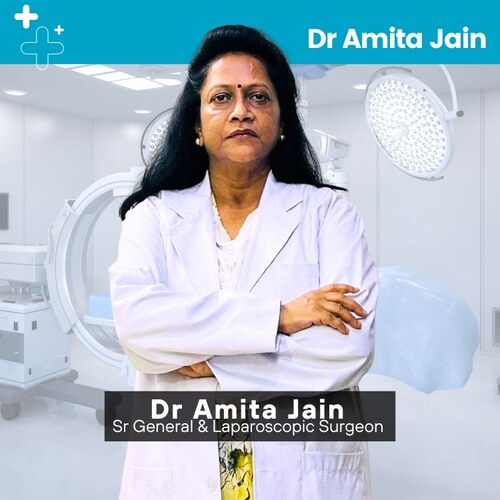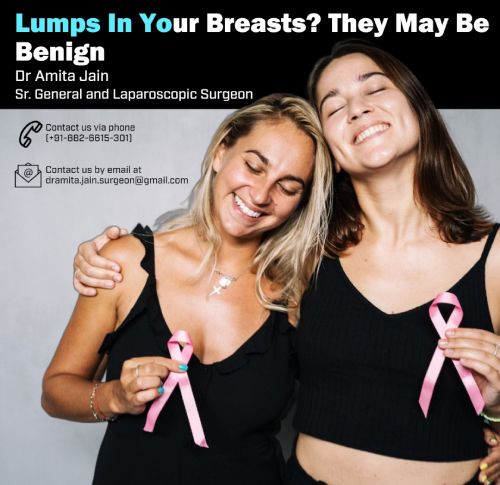Dr Amita Jain is Here to Take your Worries Away
What are Breast Lumps: Causes, Types, and Treatment?
Breast health is a vital aspect of overall well-being for women of all ages. Among the various concerns related to breast health, breast lumps are often a source of anxiety and uncertainty. While discovering a lump in the breast can be unnerving, it’s essential to understand that not all lumps are cancerous. In this article, Dr Amita Jain, India’s top laparoscopic surgeon for breast benign and malignancy sheds light on breast lumps, their types, causes, and treatment options if needed.
Understanding Breast Anatomy
Before delving into breast lumps, it’s essential to grasp the basic anatomy of the breasts. The breasts consist of glandular tissue (lobules) which produces milk during breastfeeding, fatty tissue that determines breast size while connective tissue holds glandular and fatty breast tissue in place.
What is Benign breast disease?
Benign breast lumps refer to abnormal growths within the breast tissue that do not possess the characteristics of cancerous tumors. While they are not life-threatening, it is crucial to monitor them regularly and consult a healthcare professional for proper evaluation and diagnosis.
No Gender Bias
Benign breast disease can affect both men and women. Men may experience gynecomastia, leading to enlarged and lumpy breasts.
What is the difference between Benign and Malignant?
- Benign lumps have smooth edges while cancerous lumps have irregular or jagged edges.
- Benign lumps are movable; malignant lumps are fixed and immovable.
- Benign lumps usually maintain a consistent shape while cancerous lumps may change in size and shape over time.
- Most benign lumps feel relatively soft or rubbery to the touch, whereas malignant lumps might be harder and more rigid.
What are the Types of Benign Breast Lumps?
- Cysts: Cysts are fluid-filled sacs that can develop in the breast tissue. Usually, women aged 35-50 are affected. They may grow bigger in size and more painful just before the period (menstruation). They can feel either soft like a fluid-filled blister near the surface or hard when deeper inside the breast tissue, covered with tissue. Usually non-cancerous, these cysts may result from blocked breast glands.
- Fibroadenomas: These are the most frequent benign, solid, and smooth lumps, typically found in women aged the 20s to 30s but can occur at any age. They’re the most prevalent noncancerous lumps in women and are now seen more in postmenopausal women using hormone therapy. These painless, rubbery lumps are freely movable and can vary in size, developing anywhere in breast tissue.
- Fibrocystic Changes: Fibrocystic breast changes arise from hormonal fluctuations during menstrual cycles. Breasts develop tender lumps and nipple discharge before periods due to widened milk ducts and tissue cysts, commonly affecting women aged 35 to 50. Postmenopausal women experience fewer changes. Treatment is usually unnecessary, but pain relief measures may be advised.
- Mammary Duct Ectasia: In this condition, the milk ducts beneath the nipple become dilated and inflamed. This may lead to nipple discharge or inversion. It affects menopausal and postmenopausal women. Referred to as periductal mastitis, it does not elevate cancer risk. Antibiotics are required only if a bacterial infection caused inflammation and blockage; otherwise, no treatment is necessary.
Common Causes:
- Genetics-family history of breast lumps or breast cancer may increase the likelihood of developing lumps.
- Mastitis or breast infection
- Use of Contraceptives and hormone replacement therapy
What are the Treatment Options?
Usually, benign breast conditions do not require immediate treatment. Instead, healthcare providers may recommend periodic observation and monitoring to track any changes in the breast tissue. Unless you have been diagnosed with atypical hyperplasia or some other type of benign breast disease, then the doctor might advise the following options:
- Fine needle aspiration is used to drain fluid from the cysts
- Lumpectomy—surgical removal of lumps
- Oral antibiotics for mastitis
Conclusion
If you discover a lump, don’t hesitate to consult a doctor immediately.

Dr Amita Jain is one of the most experienced and highly skilled general and laparoscopic surgeons in Delhi and India. Known for her exceptional surgical precision and patient-first approach, she offers expert care across a wide range of procedures, using both open and minimally invasive techniques to ensure faster recovery and better outcomes. Dr Amita Jain holds 28 plus years of rich experience in Trauma and General Laparoscopic Surgeries (including Gallbladder stone removal, appendix removal, hernia repair surgery, piles and fissure surgeries). She was the Professor Surgery of at the Army College of Medical Sciences. In 1994 she was commissioned as Surgeon under the United Nations Mission in Congo. From 2020 to 2022, she worked with Bansals Hospital. Currently, Dr Amita Jain is the Sr. General and Laparoscopic Surgeon at Rainbow Children Hospitals, Malviya Nagar, Delhi.
As a top female surgeon in Delhi, Dr Amita Jain brings decades of experience, compassion, and a commitment to surgical excellence. She has undergone advanced training in trauma surgery and has successfully performed numerous complex procedures, including life-saving surgeries, vascular repairs, mangled limb reconstructions, and critical care surgeries. Whether it’s a planned surgery or an emergency situation, patients across Delhi trust Dr Amita Jain for her expertise, integrity, and results-driven approach to general and laparoscopic surgery.
Call Us at +(91) 882-6615301

